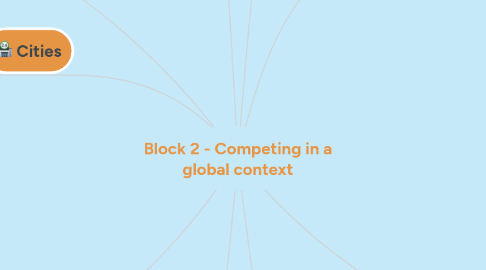
1. Exchange Rates & Taxation
1.1. Tax
1.1.1. Arm's Length
1.1.2. Transfer mispricing
1.1.3. Unitary
1.2. Exchange Rates
1.2.1. Fluctuations of value
1.2.2. Supply
1.2.2.1. Demand
1.2.3. Equilibrium
1.2.4. McBurger
1.2.4.1. Comparable
1.2.5. Currency
1.2.5.1. Country
1.2.6. Intervention
1.2.6.1. Government
1.2.6.1.1. Increase Interest Rates
1.2.6.1.2. Buy own Currency
2. Cities
2.1. Sustainability
2.1.1. Autonomy
2.1.2. Participation
2.1.3. Sharing
2.1.4. Transformation
2.2. Comparable to Countries
2.2.1. Large Population
2.2.2. Challenges
2.2.2.1. Transport
2.2.2.2. Security
2.2.2.3. Education
2.3. Leadership
2.3.1. Civic
2.3.2. Political
2.3.3. Managerial
2.3.4. Business
2.3.5. Elements
2.3.5.1. Actors
2.3.5.2. Structures
2.3.5.3. Processes
3. Supply Chain
3.1. Outsourcing
3.1.1. Loss of Control
3.1.2. Cheaper
3.2. Efficencey
3.2.1. Bullwhip
3.3. Suppliers
3.3.1. Partnership
3.3.1.1. Lamberts 3 category's
3.4. Vertically integrated
3.4.1. Direction
3.4.2. Extent
3.4.3. Balance
4. Culture
4.1. Convergence
4.2. Divergence
4.3. Crossvergence
4.4. Innovation/Comparison
4.5. Ethics
4.5.1. Target lower income consumers
4.5.2. Geographical segregation
4.5.3. Consumer protection
4.6. Corporate Social Responsibilities
5. Operations
5.1. Strategy
5.1.1. Home country with exports
5.1.2. Multi Domestic
5.1.3. Regional Operations
5.1.4. Global Coordination
5.2. Off shoring and Re shoring
5.2.1. Domestic
5.2.2. Reactive
5.2.3. Proactive
5.2.4. Global sourcing
6. Marketing
6.1. Branding
6.1.1. Global
6.1.2. Innovation
6.1.3. Brand tribes/communities
6.1.4. Mass/Niche
6.1.5. Reputation
6.1.6. Logo/Name
6.2. Marketplace
6.2.1. Expansion Triggers
6.2.1.1. Competition/cost
6.2.1.2. Saturation/small
6.2.1.3. Customers
6.2.1.4. Low Growth
6.2.1.5. Portfolio balance
6.2.2. Macro Environment
6.2.2.1. STEEPLE
6.2.3. Micro Environment
6.2.3.1. Market size
6.2.3.2. Competition
6.2.3.3. Costs
6.2.3.4. Profit Potential
6.2.3.5. Market Access
7. Finance & Economics
7.1. Balance of payments
7.1.1. Current
7.1.2. Capital
7.1.3. Financial
7.2. Foreign Direct Investment
7.2.1. Operational control
7.3. Differing Jurisdictions
7.3.1. Financial Reporting
7.3.2. Accounting Change
7.3.3. Regulations
7.4. Governing bodies
7.4.1. IFRS
7.4.2. IASB
7.4.3. G20
7.4.4. IMF
7.4.5. IFAC
7.5. Evolving Regulation
7.5.1. Stewardship
7.5.2. Imperialism
7.5.3. Taxation
7.5.4. Borrowed Finery
8. Human Resource Management
8.1. Challenges
8.1.1. Race to the Bottom
8.1.2. Stakeholders
8.1.3. Progression
8.2. Employer Relations
8.2.1. Finding talent
8.2.2. Create Opportunities
8.3. Employment
8.3.1. Technology
8.3.2. Competition
8.3.3. Legislation
8.4. Labour Market
8.4.1. Outsourcing
8.4.2. Multiculturism
9. Competition
9.1. Environment
9.1.1. World Trade Organisation
9.2. Comparative Advantage
9.2.1. Relative (Ricardo)
9.2.1.1. Specialism
9.2.2. Absolute (Smith)
9.2.2.1. Price
9.3. Diamond Model (Porter)
9.3.1. Firms & Rivalry
9.3.2. Demand Conditions
9.3.3. Related & Supporting Industries
9.3.4. Factor Conditions
9.4. Five Forces (Porter)
9.4.1. Direct Industry Competitors
9.4.2. Suppliers
9.4.3. Buyers
9.4.4. Potential Entrants
9.4.5. Substitute goods/services
